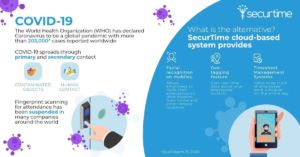 With the number of coronavirus-infected (COVID-19) individuals crossing 203,000 worldwide, the World Health Organization (WHO) has declared it to be a global pandemic. In India, the number of infected, while relatively smaller is steadily on the rise. Individuals are apprehensive about the pitfalls of being in the same vicinity as an infected person since the virus spreads mainly through primary and secondary contact. Working professionals are reluctant to travel or even commute locally, lest they face the risk of getting infected. Organizations are doing their best to tackle the threat and also fight fear and panic.
With the number of coronavirus-infected (COVID-19) individuals crossing 203,000 worldwide, the World Health Organization (WHO) has declared it to be a global pandemic. In India, the number of infected, while relatively smaller is steadily on the rise. Individuals are apprehensive about the pitfalls of being in the same vicinity as an infected person since the virus spreads mainly through primary and secondary contact. Working professionals are reluctant to travel or even commute locally, lest they face the risk of getting infected. Organizations are doing their best to tackle the threat and also fight fear and panic.
To combat this, organizations are fast putting in place policies that would ensure that their core operational functions are not affected while protecting the well-being of their employees. Two such significant policies are on the use of biometrics for attendance tracking and on the implementation of a ‘work from home’ option for employees.
Enterprises that monitor their daily employee turnout with biometric attendance punch in and punch out systems at their offices’ premises have significant cause for concern. Therefore, to decrease the chance of contact, some companies have moved to a card-based system, that lets their employees swipe in and out to record attendance. However, this method has the potential to increase the chances of proxy punching as there is no way to verify if the card owner is the one marking the attendance. To tackle these issues, organizations are looking at other fool-proof methods like online attendance records or making use of comprehensive attendance management systems available in the market that have biometric capabilities like interactive facial recognition technology, retina scanning, and voice recognition incorporated into it. Companies can leverage such technologies to minimize the risk of a virus spread through touch, and making the entire process much more stress-free.
In some cases, multiple employees in an organization would have fallen prey to the virus, and there would be a need for the entire office premises to be sanitized before operations can be resumed. This is a scenario that would warrant the use of a time attendance system so that employees can log in remotely, and the business process can continue without interruptions. Time attendance management systems available today are cloud-based systems that ensure that the data entered by employees is 100% accurate and that it is backed up into the cloud for future reference so that there is transparency for both the employer and the employee. Timesheets would enable the organizations to keep track of the work done by an employee each day. Consequently, when payroll processing is done at the end of the month, this data can be retrieved from the cloud-based systems and used to accurately calculate payroll and ensure that there are no payroll leakages.

Sample Use case – Employees in IT/ITES units:
Scenario: Consider another case of a leading IT/ITES Company that has detected a few cases of COVID-19 infected individuals among their office staff. Shutting down operations for entire weeks until the situation resolves itself would result in a massive loss of revenue for the company.
Solution: If the company has a mobile-based facial recognition app on the own device which can record attendance effectively, employees can then log in remotely with virtual check-ins can ensure that work goes on without any major hiccups. Having these precautionary measures in place would significantly reduce the chances of employees coming in contact with infected individuals and getting infected themselves.
The COVID-19 outbreak may not be the last time organizations need to collaborate with employees to help them have a smooth working experience. Future-proofing our workforce management and time attendance systems will do us good in the face of similar scares in the future.

